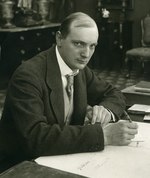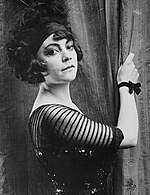Gypsy Blood (1911)
| Movie | |
|---|---|
| Original title | Gypsy blood |
| Country of production | Germany |
| original language | German |
| Publishing year | 1911 |
| length | approx. 31 minutes |
| Rod | |
| Director | Urban Gad |
| script | Gebhard Schätzler-Perasini |
| production | German Bioscop for projection working group "Union" |
| camera | Guido Seeber |
| occupation | |
| |
Zigeunerblut is a German silent film drama in three acts by Urban Gad from 1911. The film, considered lost, was also shown under the alternative title Die Vagabundin or Eine Vagabundin .
action
Baron Korff lives with his mother Hortense on the remote Schloss Felseck estate. There is no regular contact with the outside world. Only with Countess Leonie von Hohenstein, an orphan and owner of the nearby Birkenfeld Castle, there are friendly ties that have developed into a love between Korff and Leonie over the years.
One day they both meet the gypsy couple Kaspar and Luscha on a walk. Korff is carried away by the classy Luscha, but hurries away when he feels Leonie's jealousy. The next day Korff meets Luscha again in the village inn. She was caught trying to steal money from the inn's treasury and is now to be handed over to the police. Korff, however, can buy them out. He secretly follows Luscha into the forest and invites her to his castle for the next day. Kaspar follows Luscha unnoticed to the castle and threatens Korff with a knife. Luscha succeeds in disarming Kaspar. While Korff is driving Kaspar out of the castle, Luscha steals his wallet. Korff notices that his money is missing, but Luscha is able to draw suspicion on Kaspar. A little later he was arrested because the money was found in the gypsy car.
Luscha is now free for Baron Korff, who presents her to his mother as a protégé. The baroness is not very happy about her son's new company, but for the sake of her son she keeps her composure. When Countess Leonie comes to visit, Luscha demonstratively throws herself into Korff's arms and Leonie withdraws injured. Korff, in turn, tells his mother that he will marry Luscha. Luscha was given a pension in a small town not far from the castle, where she learned social manners. After a few months she receives a letter from Korff in which he informs her that his mother has died. He also offers her to come to the castle and become his wife. The wedding takes place shortly afterwards, whereby the high-ranking guests know nothing of Luscha's origin. Suddenly a servant brings Korff a message - Kaspar has been released from prison. Korff cannot prevent Kaspar from suddenly appearing at the party and describing Luscha as a vagabond and his former lover in front of everyone present. The guests leave the wedding celebration in dismay.
A year later Luscha gives birth to a son whom she calls Hans. However, the child cannot save the broken marriage. More and more often Korff withdraws to Leonie, who only knows about his feelings. Both of them go for walks regularly, as they have done before. Kaspar looks both side by side and shows Luscha the couple. She realizes that Korff no longer loves her. She wants to leave him and take revenge on him at the same time. She goes away with Kaspar and her son, but leaves pieces of clothing on and in the forest pond that are supposed to make suicide believable. A farmer brings Korff's clothes and he collapses.
Five years later, Korff lives with Leonie. One day Leonie hears music outside her door and sees a boy making music. She wants to give him money, but soon realizes that the child is none other than Hans. When she sees Luscha nearby, she takes Hans and rushes to Korff, who is speechless with happiness when he sees his son, who was believed dead. Luscha leaves the reunited family without a word. The next day, rail workers find her body on a railway embankment nearby.
production
Gypsy blood was the third film in the Asta Nielsen / Urban Gad series of 1911/1912 after The Black Dream and In the Big Moment . It was shot within a week in the summer of 1911 in the Bioscop studio at Chausseestrasse in Berlin. The buildings of the film were created by Robert A. Dietrich .
On September 30, 1911, censors banned the film from young people. Gypsy blood finally had its premiere on October 8, 1911 in Berlin. The film was marketed internationally: it was shown in French cinemas from October 1911 (as La tzigane ), was released in Danish cinemas on January 10, 1912 under the title Landevejens Pige, and was also shown in Italy (as La Zingara ) in 1912 . From April 1912, the film was marketed in America under the title Gypsy Blood, making it the first Asta Nielsen film to be released in the United States.
There is no known copy of the 860 meter long silent film (approx. 31 minutes at 24 frames / s).
literature
- "Gypsy Blood" . In: Heide Schlüpmann, Eric de Kuyper, Karola Gramann, Sabine Nessel, Michael Wedel (eds.): Nachtfalter. Asta Nielsen, her cinema . 2nd Edition. tape 1 of the Asta Nielsen edition. Verlag Filmarchiv Austria, Vienna 2010, ISBN 978-3-902531-83-4 , pp. 33-39 .
Web links
- Gypsy blood in the Internet Movie Database (English)
- Gypsy blood at the Danske Film Institute
Individual evidence
- ^ The films shown in France . In: Heide Schlüpmann, Eric de Kuyper, Karola Gramann, Sabine Nessel, Michael Wedel (eds.): Impossible love. Asta Nielsen, her cinema . 2nd Edition. tape 1 of the Asta Nielsen edition. Filmarchiv Austria, Vienna 2010, pp. 426 .
- ↑ Giovanni lasi: Polarstern: In Italy . In: Heide Schlüpmann, Eric de Kuyper, Karola Gramann, Sabine Nessel, Michael Wedel (eds.): Impossible love. Asta Nielsen, her cinema . 2nd Edition. tape 1 of the Asta Nielsen edition. Filmarchiv Austria, Vienna 2010, pp. 373 .
- ↑ Jennifer M. Bean, “Brought Across the Sea,” In America, 1912–1914 . In: Heide Schlüpmann, Eric de Kuyper, Karola Gramann, Sabine Nessel, Michael Wedel (eds.): Impossible love. Asta Nielsen, her cinema . 2nd Edition. tape 1 of the Asta Nielsen edition. Filmarchiv Austria, Vienna 2010, pp. 339 .

